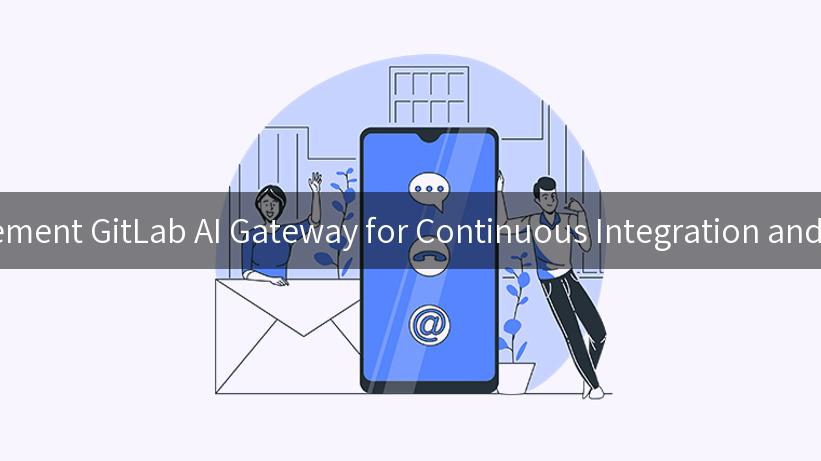
In today’s fast-paced tech landscape, companies are continually adapting to the needs for rapid development, deployment, and robust security measures. Implementing a GitLab AI Gateway for Continuous Integration and Deployment (CI/CD) stands out as an innovative solution. By leveraging platforms like Azure, alongside an API Open Platform, teams can ensure streamlined workflows while maintaining enterprise security in AI operations. In this article, we’ll explore how to set up the GitLab AI Gateway effectively while ensuring a secure enterprise environment.
Understanding GitLab CI/CD and AI Gateway Integration
GitLab is a web-based DevOps lifecycle tool that provides a Git repository manager with built-in CI/CD capabilities. When integrated with AI features through an AI Gateway, GitLab provides organizations the ability to automate and optimize various tasks, from code quality checks to deployment strategies.
Benefits of Integrating AI in CI/CD
- Enhanced Error Detection: AI-driven tools can analyze commit logs and detect potential issues before they propagate down the deployment pipeline.
- Performance Insights: With data-driven insights, organizations can optimize their CI/CD processes.
- Resource Management: AI algorithms help in predicting server load and resource allocations, ensuring optimal performance during peak times.
- Automated Alerts: Through an API Exception Alerts system, teams receive real-time notifications for any issues that arise during the integration or deployment processes.
Step-by-Step Guide to Implement GitLab AI Gateway for CI/CD
Step 1: Setting Up GitLab CI/CD
Before integrating AI, ensure your GitLab CI/CD is effectively set up.
- Go to your repository in GitLab.
- Navigate to
Settings > CI/CD.
- Enable the CI/CD function and define your pipeline configuration in a
.gitlab-ci.yml file.
Example of a Basic .gitlab-ci.yml Configuration
stages:
- build
- test
- deploy
build:
stage: build
script:
- echo "Building the project..."
- npm install
test:
stage: test
script:
- echo "Running tests..."
- npm test
deploy:
stage: deploy
script:
- echo "Deploying application..."
- npm run deploy
Step 2: Introducing Azure AI Services
To leverage AI capabilities, we will utilize Azure services. Azure provides various AI tools, such as Azure Cognitive Services, that can enhance our pipeline.
- Create an Azure account and subscribe to Azure AI services.
- Choose the specific AI services relevant to your deployment needs.
Step 3: Implementing the AI Gateway
- Select an AI Open Platform: Opt for a service that easily integrates with GitLab.
- Configuring API Access:
- Generate API keys from the Azure portal.
- Test the API endpoints to ensure they are accessible from your CI/CD pipelines.
Step 4: Creating the AI Service Endpoint
Your endpoint setup will vary based on the chosen AI tools. For example, if you’re using a predictive model for error detection, configure the endpoint as follows:
curl --location 'https://<your-azure-endpoint>' \
--header 'Content-Type: application/json' \
--header 'Authorization: Bearer <your-api-key>' \
--data '{
"input": "Sample input data for prediction"
}'
Step 5: Integrating the AI services into GitLab CI/CD Pipeline
Modify your .gitlab-ci.yml to integrate the AI services. You can create a new job within the CI/CD pipeline that calls the API endpoint set up in the previous step.
ai_check:
stage: test
script:
- echo "Running AI quality check..."
- curl --location 'https://<your-azure-endpoint>' \
--header 'Content-Type: application/json' \
--header 'Authorization: Bearer <your-api-key>' \
--data '{
"input": "Latest commit details"
}'
Step 6: Handling API Exceptions and Enhancing Security
To ensure enterprise security while using AI, it is crucial to implement an exception alert system. This could involve setting up webhook notifications to alert teams when an API failure occurs.
- Implement API Exception Alerts: Use monitoring tools such as Azure Monitor or Grafana to keep tabs on API health.
- Set Up Real-Time Notifications: You can push notifications through services like Slack or Microsoft Teams when issues arise.
Step 7: Continuous Monitoring and Improvement
Ensure to monitor the performance of your CI/CD pipeline regularly. Utilize feedback from the AI outputs to adjust your development practices.
| Key Feature |
Description |
| Error Detection |
Identify potential flaws in code changes. |
| Performance Insights |
Analyze build and deployment efficiencies. |
| Automated Notifications |
Alerts for deployment-related issues. |
| Resource Allocation |
Ensure optimal resource management. |
Conclusion
Implementing a GitLab AI Gateway for Continuous Integration and Deployment enables organizations to not only streamline their development workflows but also secure their operations by utilizing enterprise-level AI techniques. By leveraging Azure and setting up an effective API integration, teams can monitor and optimize their deployments while ensuring response to any exceptions via an alert system. This powerful combination not only enhances productivity but also fortifies the security framework around the enterprise usage of AI.
APIPark is a high-performance AI gateway that allows you to securely access the most comprehensive LLM APIs globally on the APIPark platform, including OpenAI, Anthropic, Mistral, Llama2, Google Gemini, and more.Try APIPark now! 👇👇👇
With these steps in place, your team can effectively harness the power of AI within your CI/CD processes, paving the way for innovation and improved operational efficiencies.